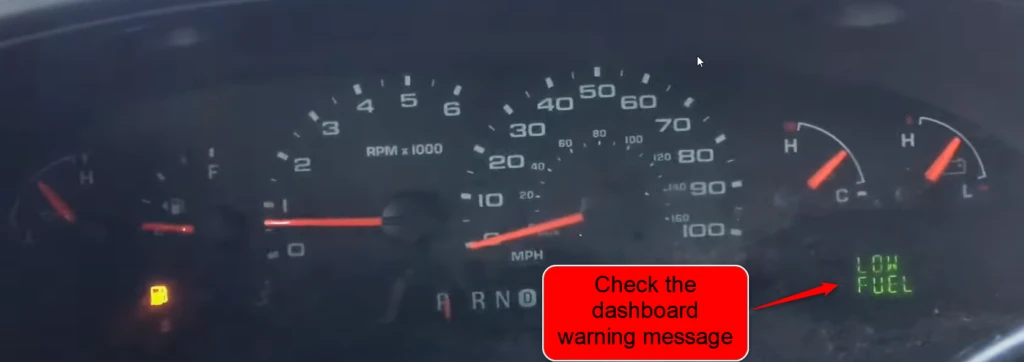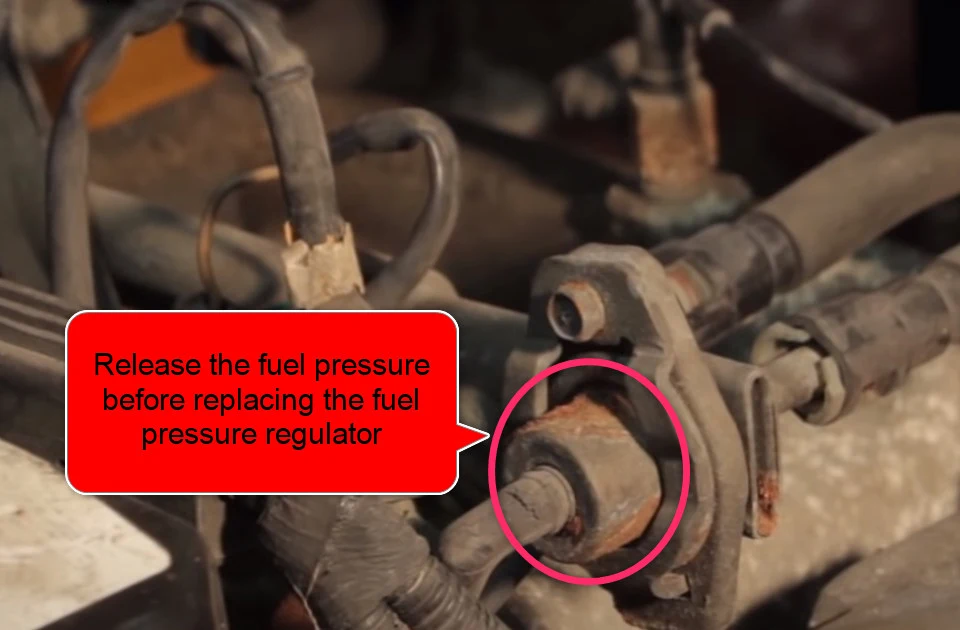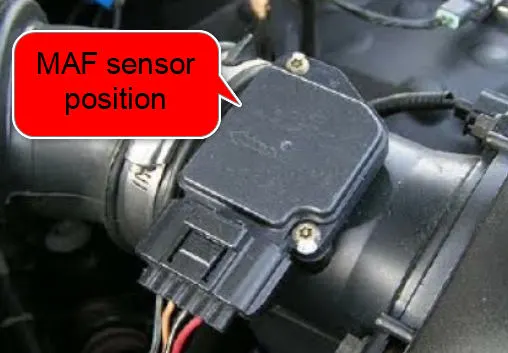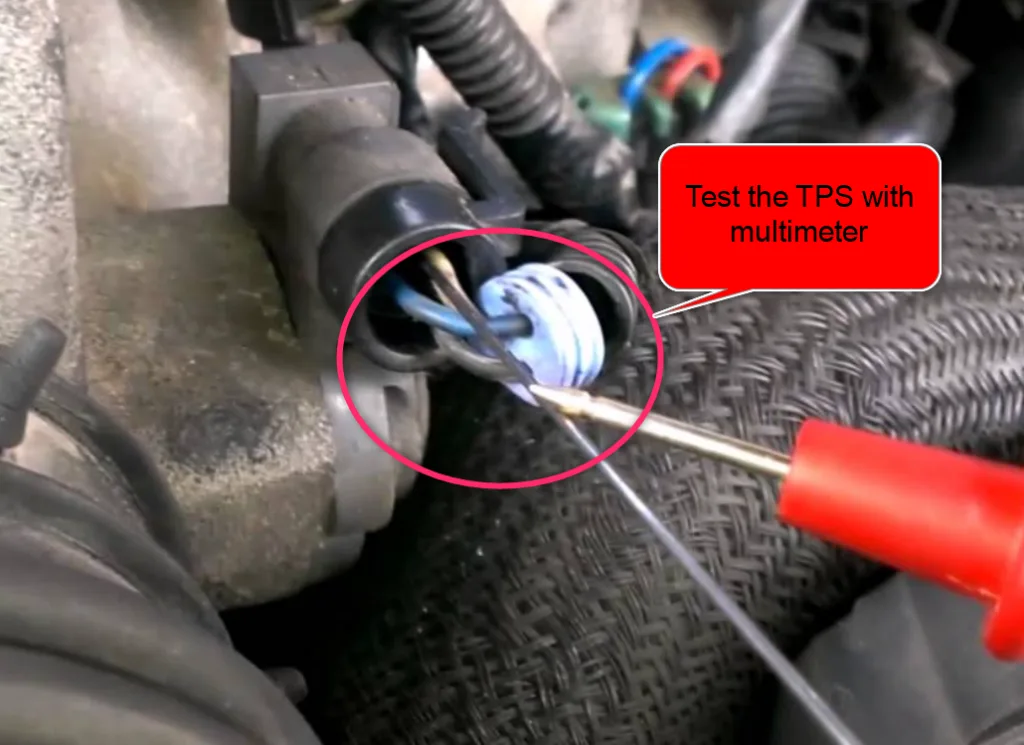Have you ever experienced the frustration of your Jeep stalling while driving? It’s not only inconvenient but also potentially dangerous. Understanding what causes this issue and finding the correct fix is crucial for a smooth and reliable ride.
Jeep stalling while driving can result from low fuel, weak spark, inadequate airflow, TPS problems, ECT sensor issues, actuator pin malfunctions, wire harnessing problems, and OPDA impact. However, you can take preventive measures to avoid these issues with proper steps and knowledge.
In this article, I will delve into the possible causes of a Jeep stalling while driving and explore the solutions to get you back on the road with confidence. So, buckle up, and let’s dive right in!
1. Low Fuel Level:
Lack of fuel is a fundamental issue that can lead to the abrupt stalling of your Jeep’s engine while driving. When a Jeep’s fuel supply runs low, the engine might shut down due to insufficient fuel.
In this section, I’ll discuss the reasons behind inefficient fuel delivery to the engine, leading to vehicle stalling.
1.1. No Gas in the Vehicle:
A primary culprit behind engine stalling is the vehicle’s low fuel levels. This is particularly crucial for off-road enthusiasts, who should always carry extra gallons of fuel to prevent encountering low fuel during off-roading adventures.

In emergencies, roadside assistance or help from a friend can be viable options.
How to Fix:
- Always monitor your fuel gauge and refill before it reaches critically low levels.
- Consider carrying extra fuel when embarking on off-road trips.
1.2. Issue Due to Fault in Fuel Pump:
Stalling can also result from the presence of a bad or clogged fuel pump. This can occur due to:
- Accumulation of dust or debris.
- The buildup of grease. Vehicles may exhibit stalling issues and unusual engine noises when a problem arises with the fuel pump.
How to Fix:
- Inspect the fuel pump for signs of clogging, dust, or debris accumulation.
- Clean or replace the fuel pump as needed.
1.3. Issue with Pressure Regulator:
Problems with the pressure regulator near the fuel pump can also lead to engine stalling.
A malfunctioning pressure regulator system, often indicated by engine stalling, can result from system failures in the vehicle.
How to Fix:
- Consult a mechanic to diagnose pressure regulator issues.
- Replace the pressure regulator if necessary.

1.4. Issue with the Fuel Filters:
Fuel filters are crucial for cleaning the gas before it reaches the engine. These filters prevent debris and particles from entering the engine, ensuring smooth operation.
However, if the fuel filters become clogged with dirt, debris, and particles, they can disrupt fuel flow and cause engine stalling.
How to Fix:
- Regularly inspect and replace fuel filters as recommended by your vehicle’s manufacturer.
- Monitor the symptoms of a clogged fuel filter and address issues promptly.
2. Problem Due to Poor Spark:
Engine stalling is often linked to the need for a spark to ignite the fuel-air mixture. The ignition and vehicle’s electrical systems play crucial roles in generating these sparks.
When issues arise within these systems, the absence of a proper spark can result in engine stalling.
Two primary reasons for spark-related engine stalling include:
- Disturbed working of the ignition coil.
- Failing of the crankshaft position sensor in the vehicle.
2.1. How Poor Crankshaft Position Sensor Causes Stalling:
The crankshaft position sensor can exhibit disruptions in its working due to an issue known as open winding. This issue often goes undetected until the temperature inside the vehicle rises.
As the temperature increases, the coil within the sensor experiences an open circuit, leading to engine stalling.
The engine may restart and function normally once it cools down. A malfunctioning crankshaft position sensor can lead to engine stalling and sometimes trigger the illumination of the check engine light as well.
How to Fix:
- To diagnose poor crankshaft position sensor performance, utilize an ohmmeter to assess its working condition.
- Seek professional assistance for testing and potentially replacing the crankshaft position sensor.
2.2. Failing Ignition Coil and Cylinder Connection:
Excessive vehicle usage can result in wear and tear within the ignition coil cylinder. This wear can disrupt the connection, leading to issues with the spark plug’s performance and, ultimately, engine stalling.
This problem is widespread when the ignition coil’s cylinder experiences wear over time, compromising the spark’s generation and fuel ignition process.
How to Fix:
- Regularly inspect and maintain the ignition coil’s cylinder.
- If you suspect issues with the ignition coil, seek professional inspection and potential replacement.
3. Lack of Air in Vehicle:
Airflow is the lifeblood of internal combustion engines, including those powering Jeeps. Engines require a precise balance of air and fuel to function optimally.
Adequate airflow is essential for several reasons:
- It ensures the proper mixture of air and fuel, enabling efficient combustion.
- It contributes to maintaining the optimal temperature within the engine, preventing overheating.
- It promotes consistent and smooth engine operation, translating into a seamless driving experience.
Environmental Challenges and Their Impact:
Jeep engines often face environmental challenges, especially during off-road adventures where dust, dirt, and debris hinder proper airflow.
These challenges can lead to engine stalling if left unaddressed. One key component that plays a pivotal role in regulating airflow is the Mass Air Flow (MAF) sensor.
The Role of the MAF Sensor:
The MAF sensor is a critical part of the engine management system. It estimates the air penetrating the engine and transmits this data to the ECU.
The ECU then adjusts the fuel-to-air ratio, ensuring optimal combustion. A malfunctioning MAF sensor can disrupt this delicate balance and lead to engine stalling.
Bad MAF Sensor Causes Engine Stalling:
If the MAF sensor goes wrong, it can result in inaccurate readings of the incoming air. This discrepancy can lead to an improper fuel-to-air mixture, causing the engine to stall.

Environmental challenges, such as dust and dirt accumulation on the sensor’s delicate components, can exacerbate this issue.
How to Fix:
- STEP 1: Regularly inspect the MAF sensor for signs of dirt, debris, or damage
- STEP 2: Clean the MAF sensor carefully using a good MAF sensor cleaner.
- STEP 3: If the above steps don’t resolve the problem, consider seeking professional assistance to diagnose and potentially replace the MAF sensor.
My Recommendation:
4. The Issue with the TPS (Throttle Position Sensor):
The throttle position sensor is responsible for sending signals for the throttle body’s opening through the vehicle’s computer system. This sensor holds a resistance in it which can change the voltage signals delivered to the computer system and the opening position of the throttle body.
It has been seen that sometimes dead spots occur on the internal resistance surface, which can create issues in the voltage signals. It causes the computer system to incorrectly adjust the air and fuel ratio, leading to stumbling and stalling of the engine.
It can even prevent the starting of the engine in some models too. Therefore, it is recommended to deal with the throttle body and position sensor initially before the occurrence of a significant problem.

How to Fix:
- STEP 1: If you suspect a malfunctioning TPS, inspect its wiring and connections for any signs of damage or corrosion.
- STEP 2: Consider using a digital multimeter to test the TPS’s resistance readings at various throttle positions.
- STEP 3: If dead spots or irregular readings are detected, replacing the TPS with a new, high-quality component is advisable.
- STEP 4: After replacement, recalibrate the TPS per manufacturer guidelines to ensure accurate signal transmission.
5. The Issue with ECT (Engine Coolant Temperature) Sensor:
The vehicle’s computer system, often referred to as the engine control unit (ECU), relies on the ECT sensor’s input to adjust the air-to-fuel ratio.
During a cold start, the ECU enriches the air-fuel mixture with extra fuel to aid ignition and prevent stalling. Conversely, if the engine overheats, the ECU responds by increasing the fuel mixture to help lower the temperature.
If this ECT sensor malfunctions, the computer system adds extra fuel to the mixture, which can cause the engine to stall.
How to Fix:
- STEP 1: Begin by checking for any error codes related to the ECT sensor using an OBD-II scanner. Also, observe the engine’s temperature gauge for anomalies while the vehicle runs.
- STEP 2: Inspect the ECT sensor’s wiring and connections for damage, corrosion, or loose connections that might be causing faulty readings.
- STEP 3: Use a digital multimeter to measure the ECT sensor’s resistance at different temperature levels. Compare the readings with manufacturer specifications.
- STEP 4: If you identify inconsistent or out-of-spec readings, replace the ECT sensor with a compatible, high-quality replacement part.
- STEP 5: After installing the new ECT sensor, recalibrate the ECU as per manufacturer guidelines to ensure accurate temperature readings and fuel mixture adjustments.
6. The Issue with the Actuator Pin:
The actuator pin serves as a bridge between the ignition switch and the engine’s fuel system. It operates within the ignition switch, responding to the signals initiated by the key’s insertion and manipulation.
This metallic rod within the switch acts as a catalyst, transmitting the signal that ignites the engine’s motor.
6.1. Actuator Pin’s Role in Engine Stalling:
The actuator pin's role becomes particularly pronounced when it falters. The ignition switch relies on the actuator pin's proper function to establish a seamless connection between the fuel system and the ignition.
If this connection encounters disruptions, the result can be the unexpected phenomenon of engine stalling while driving.
6.2. Impact of Ignition Switch Dysfunction:
Malfunctions within the ignition switch, specifically related to the actuator pin, can create a breach in the crucial connection that ties the fuel system and the ignition together.
This breach can lead to intermittent stalling episodes during operation. Engine stalling under these circumstances occurs due to the impaired communication between the ignition switch and the fuel system.
How to Fix:
To prevent actuator pin-related engine stalling issues, proactive steps are necessary.
Let me explain the methodical approach to address the situation:
- STEP 1: Begin by carefully removing the ignition switch from the steering column. This step necessitates a cautious approach to avoid any damage during disassembly.
- STEP 2: Once the ignition switch is detached, remove the actuator pin housed within the ignition lock cylinder assembly.
- STEP 3: Transition to installing the new actuator pin, ensuring proper alignment within the ignition lock cylinder assembly. The precise installation guarantees seamless communication between the ignition switch and the fuel system.
- STEP 4: Reassemble the components, securing the ignition lock cylinder assembly and ensuring a snug fit.
7. The Problem of Wire Harnessing:
The intricate wiring network is often exposed to varying heat levels, especially in the engine compartment. This exposure can lead to wear and tear over time, potentially compromising the integrity of the wiring.
Additionally, moisture accumulation, a common consequence of environmental conditions, can infiltrate the wiring, resulting in short circuits that disrupt the normal functioning of the vehicle.
The repercussions of poor wiring can manifest as engine stalling, creating an unsettling and potentially hazardous situation. Stalling occurs when the compromised wiring interferes with transmitting essential signals and data within the vehicle.
This disruption can interrupt the delicate balance required for the engine to function smoothly, causing it to stall unexpectedly.
How to Fix:
Mitigating the risk of engine stalling due to poor wiring involves proactive measures and thorough inspection:
- STEP 1: Regularly examine the wiring throughout the vehicle, paying close attention to areas more exposed to heat and moisture, such as the engine compartment.
- STEP 2: Utilize proper fastening mechanisms, such as bolts and clips, to secure the wiring within the harness. This preventive step helps minimize the risk of sudden short circuits that can lead to stalling.
- STEP 3: Identify and reinforce vulnerable points where wiring is more likely to face wear and tear. Employ protective measures such as heat-resistant shielding and moisture-resistant seals to shield the wiring from potential sources of damage.
8. Impact of the OPDA (Oil Pump Drive Assembly):
The OPDA, residing within the engine’s anatomy, is entrusted with a pivotal responsibility—driving the oil pump. This act ensures the proper circulation of oil, a lifeline for the engine’s components, by maintaining optimal lubrication levels.
The synchronous harmony between the OPDA and the engine’s internal workings is key to sustaining your Jeep’s robust performance.
Yet, the OPDA’s role extends beyond oil circulation. In certain Jeep models, ranging from 1992 to 2006, a vulnerability emerged within the standard OPDA design. This vulnerability centered around two bronze oil bushings separated by an oil seal.
As the OPDA deteriorates due to its design flaw, it can trigger a series of consequences, including engine stalling. The failure of the OPDA results in insufficient lubrication, a condition that endangers the engine's health and can ultimately lead to catastrophic engine failure.
The symptoms of a faltering OPDA often start subtly, with signs of difficulty in acceleration, hard shifting, and even oil leaks. These early indicators serve as an ominous warning of potential engine stalling in the making.
How to Fix:
- Timely Replacement: If your Jeep falls within the range of models prone to this OPDA vulnerability, consider proactively replacing the assembly as part of your regular maintenance routine. A preemptive replacement can circumvent the potential consequences of an aged and compromised OPDA.
- DIY Repair: Remarkably, addressing the OPDA issue is well within the realm of a hands-on individual. The process involves replacing the assembly and doesn’t necessitate specialized tools. Countless resources, including instructional videos, guide you through the procedure.
- Long-Term Assurance: Opt for high-quality replacement parts to fortify your vehicle’s longevity and reliability. By selecting components known for their resilience, you reinforce your Jeep’s ability to traverse the terrain without the specter of engine stalling.
Category and Causes for Jeep Stalling:
Category | Possible Causes |
Fuel Related Issues |
|
Spark Issues |
|
Lack of Airflow |
|
Engine Coolant Temperature |
|
TPS Problems |
|
Actuator Pin |
|
Poor Wiring |
|
How to React to a Sudden Engine Stalling- Staying Calm and Ensuring Safety:
The sudden jolt of engine stalling can be unnerving, particularly when it occurs while you’re navigating the roadways.
However, maintaining composure and following a well-considered protocol is essential to ensure your safety and that of those around you.
1. Pulling Over and Activating Hazard Lights: A Prudent First Step
The instant you sense engine stalling, your first instinct should be to guide your vehicle to a safe location.
If you’re on a highway, coast towards the shoulder, or within a city, steer towards a parking lot or a quiet side street.
As you transition to a secure spot, activate your hazard lights to signal to other motorists that your vehicle is experiencing a challenge.
This precautionary measure is vital in situations of reduced visibility or heavy traffic, where it becomes imperative to alert surrounding drivers to your vehicle’s slowed pace or stationary status.
2. Attempting a Restart and Basic Checks: Assessing the Situation
Once you’ve come to a halt, take a deep breath and diagnose the issue. Begin by attempting to restart the engine. Turn the key or press the start button while ensuring the transmission is in “Park” (or “Neutral” for manual transmissions).
If the engine roars to life, the stalling might have been a transient glitch. However, if the engine remains dormant, move on to a preliminary inspection.
Check your fuel gauge to ascertain if the vehicle has run out of fuel. Ensure that your battery connections are secure and there are no visible signs of corrosion.
Additionally, inspect the oil pressure and coolant temperature gauges to ensure your engine’s vitals are within acceptable ranges. These basic checks might provide insights into the cause of the stalling and can guide your subsequent actions.
3. Seeking Professional Help and Towing Services: Knowledgeable Assistance
Should your attempts to restart the engine prove futile, or if you’re unable to identify the cause of the stalling, it’s time to seek the expertise of a professional mechanic.
If you're not within a reasonable distance of a trusted mechanic's shop, consider contacting a roadside assistance service. These professionals have the tools and know-how to diagnose and potentially address the issue on the spot.
In certain scenarios, engine stalling might be symptomatic of a more complex problem that requires extensive repairs.
If the vehicle is inoperable or poses a safety risk, opting for towing services is judicious. Towing ensures the vehicle’s secure transportation to a repair facility, where specialized technicians can diagnose and remedy the issue comprehensively.
Preventive Measures to Adopt During Stalling of Jeep:
Stalling is a common problem riders face, creating hindrances in their off-roading experience. Here I will discuss some precautionary measures which you can adopt to prevent the vehicle from stalling:
- The first and foremost step is to avoid panic if your vehicle starts stalling during the middle of your off-roading in a far area. Stay calm and deduct a strategy to deal with this issue.
- When you observe the first ever sign of stalling of your engine, move immediately to the side instead of waiting for the engine to die out.
- Turn the hazard and engine lights on to warn the other riders that you are facing a problem in your vehicle. This method will help you to grab immediate help or assistance too.
- Restart the engine and transfer the vehicle’s manual transmission to a neutral state. If you have an automatic transmission, then park the vehicle nearby.
- Check out the vehicle’s components, including the air filters, sensors, and battery, to confirm whether they are in a good state or not.
- It is better to seek help from mechanical assistance if the problem is severe to tackle immediately.
Recommendations for Preventing the Stalling in Jeep:
Here we will discuss some recommendations that prevent the stalling of Jeep during driving:
- Learning driving tactics like handling the clutch mode while driving the manual transmission in your Jeep is recommended. The engine cannot handle the sudden release of the clutch, which makes it stall.
- Release the clutch slowly and gently way in a standstill position. It is better to depress it slowly before entering the first gear and pulling it away.
- It is recommended to inspect the vehicle thoroughly at least once a week to detect any problem with the components, if any. You can deal with the issues of rust or corrosion beforehand, as it can stall the engine.
- Whenever you get the sign of the improper working of components like a fuel pump, battery, or alternator, it is better to consider these signals as warning signs that the component needs repairing. The poor working of these components can make the engine stall.
- It is recommended to keep an eye on the air filters and keep them away from clogging.
- It is also recommended to adopt the habit of checking the gas tank that either is near the maximum mark so that you never face the problem of an empty gas tank.
Final Thought:
Understanding the potential causes of engine stalling in a Jeep while driving is crucial for maintaining a safe and uninterrupted driving experience. Whether it’s fuel-related issues, ignition problems, airflow disruptions, or mechanical malfunctions, staying informed empowers you to take prompt action.
By remaining calm, following proper protocols, and seeking professional help when needed, you can effectively address and prevent stalling incidents, ensuring your safety and the reliability of your Jeep’s performance on the road.
Also Read:
7 Reasons Jeep Wrangler Cruise Control Stops Working (Fixed)
Are Jeep Wranglers Good in Winter/Snow? (Detailed Analysis)
Jeep Wrangler Automatic Transmission Shifting Problems (Fix)
Is The Bronco Sport Good in Snow? All You Need to Know
How Many Miles Can You Drive on Snow Chains?
How are Mud Tires in Snow? All You Need to Know
Are Jeep Patriots Good in Snow? What You Need to Know
How to Copy Jeep Key- All You Need to Know
Frequently Asked Questions (FAQs):
What are some of the most common reasons why Jeeps show the issue of stalling?
The common reasons for stalling in Jeeps during driving are the problems:
- Poor fuel system
- Poor system of air intake
- Poor ignition system
- Bad throttle position sensors in the vehicle
Why does the Jeep stall during driving?
There are various reasons why Jeeps stall during driving, including bad airflow sensors, fuel pumps, and ignition coils. Poor crankshaft position sensors and clogged fuel filters can also be a reason behind stalling in Jeep.
Which kind of sensors can lead to the issue of stalling in Jeeps?
The presence of sensors in poor condition, such as:
- Mass airflow sensor is known as MAF
- Engine coolant temperature sensor known as ECT
- Manifold absolute pressure sensor is known as MAP
Does the problem of stalling can damage the engine of Jeeps?
Stalling of vehicles is not considered bad for the engine and vehicle. But if this issue is observed about 8-10 times each day, it becomes difficult to cope with it. It has been noticed that stalling is mostly seen in the reverse gears, so you can tackle the problem over here.
What are the signs which can be indicated as stalling signs?
The signs which can be indicated as stalling in the vehicle are:
- Dropping of wind and nose
- Difficulty in maintaining the level of flight
- Difficulty in maintaining the level of buffet
How can a person control stalling in a vehicle?
Stalling can be controlled by dealing with the causes and fixing the damaged or damaged components, such as fuel filters, air filters, catalytic converters, etc.
Is the presence of bad spark plugs in the vehicle a reason for stalling?
Bad spark plugs can be a reason for stalling. Damaged or worn-out spark plugs are not able to produce enough spark in the vehicle, which the engine requires for starting the vehicle. This can let the engine stall, showing a delayed start of the engine.

This is Surya. I am an experienced off-roader. I have been off-roading for many years across several terrains. I am passionate about 4×4 driving and want to share my knowledge and experience with others.
My goal is to provide you with the most comprehensive and unbiased information about off-roading.
I curated this article through my personal experience and expertise, and I hope it helps you with what you are looking for.


 (+91)9123743026
(+91)9123743026
 24/1 Nibedita Sarani. M.B. Road, Kolkata- 700051, India
24/1 Nibedita Sarani. M.B. Road, Kolkata- 700051, India